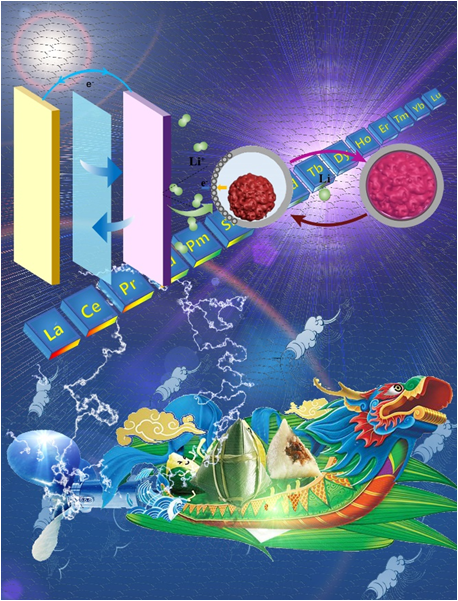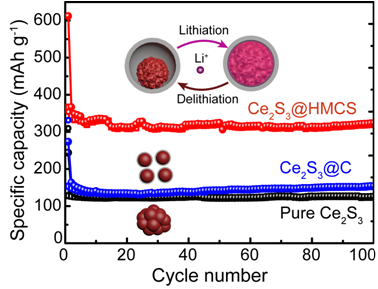Yolk-Shell Nanoarchitecture for Stabilizing a Ce2S3 Anode - Dr. Mingxue Tang
JULY 19, 2021
 |
A team of HPSTAR scientists led by Dr. Mingxue Tang has developed Stöber sol-gel method and in-shell sulfuration method craft γ-Ce2S3 nanoparticles in hollow mesoporous carbon shell with tunable voids to buffer the volume change upon electrochemical cycling for the first time. The synergetic effects of nanosized Ce2S3 core and the coating carbon shell with enhanced electronic conductivity offer enhanced rate performance. The working mechanism is unraveled with ex-situ XRD and NMR characterizing techniques. The work is published in the journal of Carbon Energy.
Rare-earth sulfides are of research interest for lithium‐ion batteries (LIBs) due to their abundant lithium intercalation sites and low redox voltage. However, their electrochemical performances are not satisfactory because of poor conductivity and volume change upon electrochemical cycling. Herein, nanoarchitectures of γ‐Ce2S3 encapsulated in a hollow mesoporous carbon nanosphere (Ce2S3 @HMCS) are fabricated using the self‐template strategy combined with the in‐sphere sulfuration method and tested as an LIB anode. The void space between the Ce2S3 core and the outer layer of the carbon nanosphere has been properly designed and modulated to achieve excellent electrochemical performance in terms of electronic conductivity, reversibility, and rate capability. The reversible capacity of Ce2S3 @HMCS is 2.6 times that of the untreated Ce2S3 anode, which can gradually increase and maintain a capacity of 282 mAh·g-1 at a current density of 1 A·g-1, and a high Coulombic efficiency (~100%) can be achieved even after 1000 cycles. This good performance is attributed to the unique yolk-shell nanostructure with a highly crystallized and stable Ce2S3 core and volume expansion buffer space upon lithiation/delithiation. Ex-situ X‐ray diffraction and nuclear magnetic resonance results indicate that the lithiation of Ce2S3 @HMCS is an intercalation process. This study represents an important advancement in precise structural design with in‐sphere sulfuration and sheds light on a potential direction for high performance lithium storage.

Caption: Nanoarchitectured Ce2S3 Anode with Tunable Void for Enhancing Electrochemical Performance.
Ref. Hui K, Fu J, Liu J, Chen Y, Gao X, Gao T, Wei Q, Li C, Zhang H, Tang M., Yolk–shell nanoarchitecture for stabilizing a Ce2S3 anode, Carbon Energy. 2021, https://doi.org/10.1002/cey2.130.
稀土硫化物具有丰富的嵌锂反应活性位点和较低的氧化还原电压,是一种潜在的锂离子电池负极材料。然而,在电池循环过程中,硫化物电极材料的内阻大、循环体积变化等问题导致其电化学性能并不理想。本工作采用自模板法结合球内原位硫化法制备了空心介孔碳纳米球包覆的γ-Ce2S3(Ce2S3 @HMCS),通过对该材料的Ce2S3内核与介孔碳纳米球壳层之间的空隙进行设计和调制,使其具有良好的导电性、循环可逆性和倍率性能。设计合成的Ce2S3 @HMCS具有可观的可逆比容量,是未做任何处理的纯的Ce2S3负极材料的2.6倍,在高电流密度为1 A·g–1条件下循环1000次以后,还能保持282 mA·h·g-1的比容量,并且库仑效率几乎为100%。这种良好的电化学性能归功于其独特的核壳中空结构,对于放电过程中Ce2S3的体积膨胀起到很好的缓冲作用。而纳米结构和碳包覆层分别提供了更多的反应位点和增强电子传导能力。通过X射线衍射和固体核磁共振研究,证明了稀土硫化物的插层锂化机制。这项工作策略是稀土硫化物球内硫化精细结构构建方面研究的重要突破,也为高性能储能材料的设计提供了新思路。
